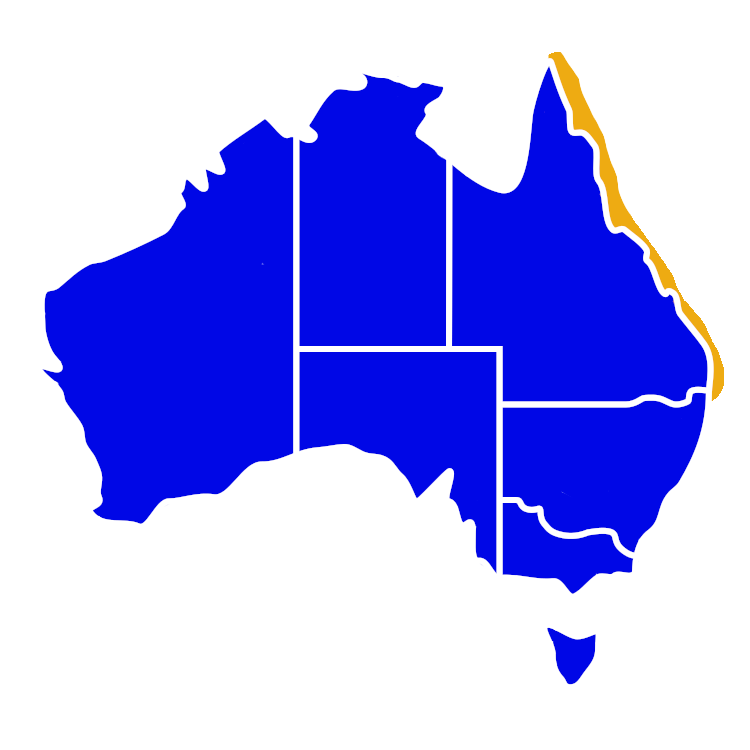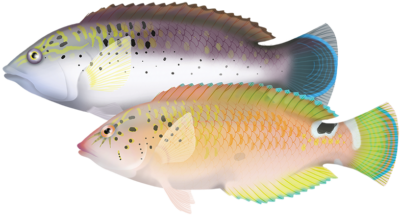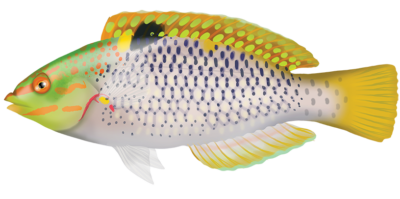Quick Facts
Distribution

Interesting Info
- The Blackback Wrasse is widely distributed along the east coast of Australia. They can be found in various regions throughout the Coral Sea, including the Great Barrier Reef in Queensland and northern New South Wales.
- They are characterised by their distinct coloration and pattern. Juveniles and females have a vibrant yellow or orange body with black markings on their backs, giving them their common name. As they transition into males, their coloration changes to a deep blue or green body with a bright yellow head and black markings.
- Blackback Wrasse are omnivorous, feeding on a diverse diet that includes small invertebrates, algae, and small fish. Their foraging behaviour often involves picking at the substrate, searching for prey items.
- Like many wrasses, Blackback Wrasse possess sharp teeth that are well-suited for capturing and consuming their prey. They have a protrusible jaw, allowing them to extend their mouth to snatch small, elusive prey items.
- These wrasses have a complex social structure, often forming harems consisting of one dominant male and several females. The male defends his territory and mates with the females within his harem.
- Breeding season for Blackback Wrasse typically occurs during the warmer months, particularly from spring to early summer. They engage in elaborate courtship rituals, where the males display vibrant colours and patterns to attract females.
- Their estimated lifespan is between 10 – 15 years.
Species Interaction
Recreational Fishing, Aquarium, Snorkeling & Diving
Blackback Wrasse are not specifically targeted for recreational fishing, they may occasionally be caught when targeting other species on the reef. They are however popular aquarium fish as they have striking colours and fascinating swimming behaviours. Blackback Wrasse are also a delight to observe for snorkelers and divers. With their vivid colours and active behaviour, they add vibrancy to the underwater landscape. They are generally curious and unafraid of human presence, allowing for enjoyable encounters in the wild.
Scientific Classification
Kingdom: Animalia
Phylum: Chordata
Class: Actinopterygii
Order: Perciformes
Family: Labridae
Genus: Anampses
Species: Anampses Neoguinaicus
Conservation Status
In Australia, the Blackback Wrasse is listed as a species of Least Concern by the International Union for Conservation of Nature (IUCN). This indicates that their populations are relatively stable and not currently facing significant threats or declines.
Fish Taste Quality
Blackback Wrasse are considered to be edible but are not a commonly consumed fish. It general, wrasse as a species are described as mild and delicate, with a slightly sweet flavour and a tender, flaky texture.
Taste Rating: 3/5
How to catch
Blackback Wrasse
Catch Difficulty: Easy
Tackle: Running Sinker Rig
Bait: Crab, Fresh cut flesh baits, Pilchards, Prawns, Squid, Worms, Yabbies
Technique: Keep bait close to the reef/structure
Popularity: Not targeted - Bycatch
Blackback Wrasse
As Aquarium Fish
Care Level: Moderate
Temperament: Peaceful
Diet: Omnivore
Reef Compatible: Yes
Minimum Tank Size: 100 gallons
Recreational Viewing
- Snorkeling & Scuba
Finding: Easy
Temperament: Peaceful
Location: Inner Reef, Outer Reef, Lagoon
Danger: None





